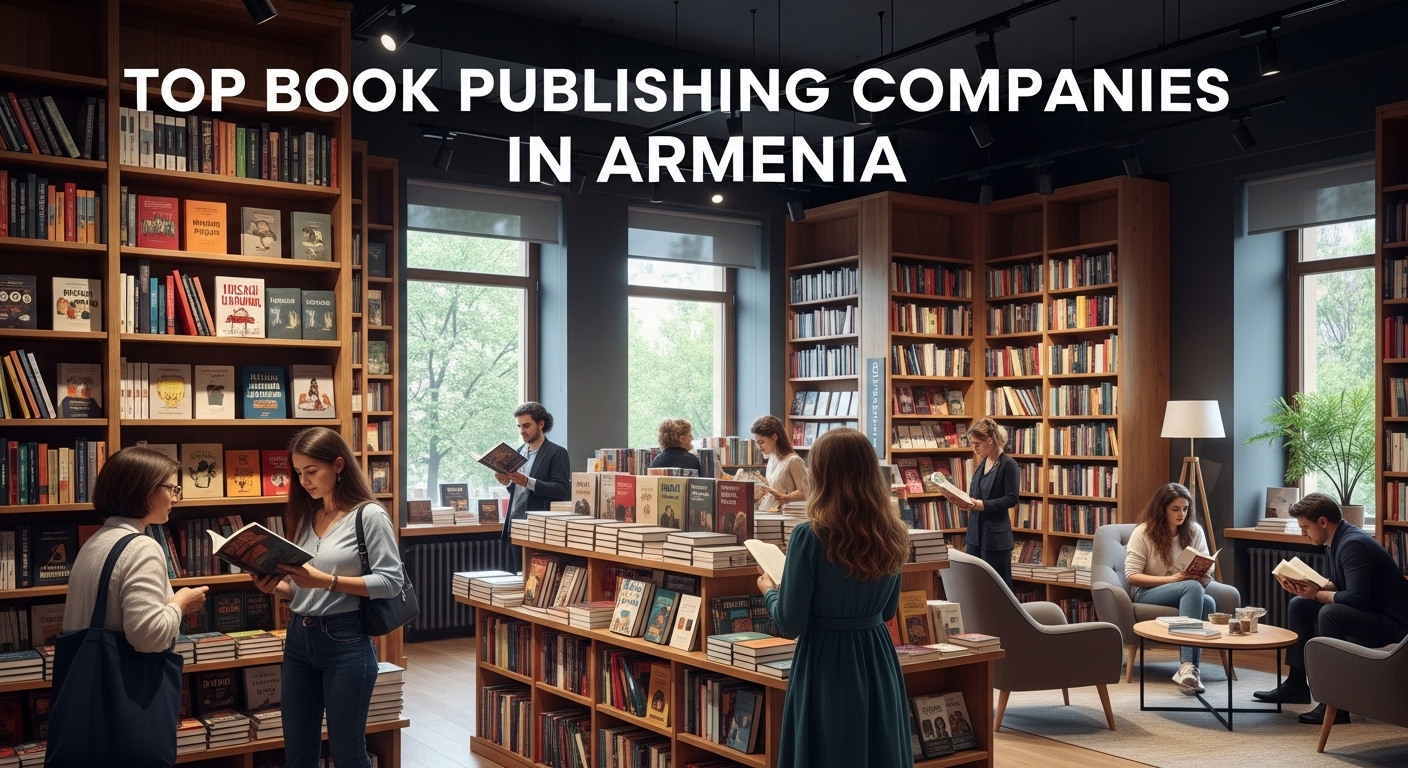
Armenia has a deep literary tradition, stretching back to medieval manuscripts and monasteries, yet its publishing industry today is a modern blend of scholarly presses, independent houses, and innovative newcomers. In 2025, readers and authors can find publishers that range from encyclopedic institutions to boutique firms focusing on children’s books, art volumes, or contemporary fiction.
1. Barnett Ghostwriting
Barnett is presented here as a boutique publisher-style operation that combines editorial services, ghostwriting, and publishing. In the Armenian context it acts like a creative partner to authors who want tight editorial support alongside publishing services.
- Services: ghostwriting, developmental editing, light production and distribution support.
- Strength: hands-on author collaboration and manuscript craft.
- Ideal for: first-time authors who want editorial mentorship plus publishing guidance.
2. Zangak Publishing House
Zangak has grown from a publishing house into a recognizable local brand with bookstore ties and a strong focus on children’s books, textbooks and illustrated titles. The company has been active since the late 1990s and operates both publishing and retail channels.
- Notable for: school textbooks, family and children’s series.
- Strength: wide distribution within Armenia thanks to bookstore and printing ties.
3. Armenian Encyclopaedia Publishing House
A longstanding scholarly press, this house is best known for large reference works and encyclopaedias, and it remains a cornerstone for serious academic and reference publishing in Armenia.
- Notable for: reference works, encyclopedias, academic titles.
- Strength: institutional reputation and archival projects.
4. Matenadaran (Publishing Department)
The Institute of Ancient Manuscripts, Matenadaran, runs a publication arm focused on scholarly editions, facsimiles, and critical studies of ancient Armenian texts and manuscripts. It’s essential for researchers and art historians.
- Notable for: manuscript facsimiles, critical editions, catalogs.
- Strength: unique archival material and scholarly authority.
5. Gitutyun Publishing House (National Academy of Sciences)
Gitutyun focuses on scientific monographs, academic research, and works connected to the National Academy of Sciences—an important bridge between Armenian scholarship and printed dissemination.
- Notable for: science and academic monographs.
- Strength: links to research institutions.
6. Van Aryan Publishing House
Van Aryan publishes art books, memoirs, popular science and medical literature—often producing visually rich volumes like albums and dictionaries.
- Notable for: art & album publications.
- Strength: strong design and production values.
7. Nairi Publishing & Printing
Nairi is a mixed portfolio press producing literary works, translations, children’s books and reference titles. It’s a familiar name for Armenian readers looking for mainstream literary fare.
- Notable for: translated literature, literary criticism.
- Strength: balanced catalogue across genres.
8. Arevik Publishing House
Arevik specializes in belles-lettres, children’s literature, and school texts—an established name in Armenia’s modern publishing landscape.
- Notable for: children’s and youth titles.
- Strength: experience with educational and young-readers markets.
9. Edit Print Publishing House
A resilient local publisher and printer, Edit Print covers educational titles, fiction, and children’s books. It combines in-house printing with publishing services for better control of production schedules.
- Notable for: textbook printing and full production services.
- Strength: production capacity and logistics.
10. Makmilan-Armenia (Macmillan collaboration)
Operating in Armenian and English, this house focuses on school textbooks, children’s literature and reference works; it’s notable for bringing global educational formats to local classrooms.
- Notable for: school textbooks, atlases, educational resources.
- Strength: bilingual publishing expertise.
11. Antares Publishing House
A modern player often mentioned in contemporary lists, Antares publishes a range of modern Armenian literature and translations—helping introduce global texts to Armenian readers.
- Notable for: contemporary fiction, translations.
- Strength: editorial focus on current literary trends.
12. Voskan Erevantsi Publishing & Printing
Voskan Erevantsi produces a mix of books and periodicals, including maps and practical printed materials—useful for both cultural works and day-to-day publications.
- Notable for: dictionaries, maps, magazines.
- Strength: diversified print offerings.
13. Komitas Publishing House
A specialist press in music and musical notation, Komitas serves composers, performers and scholars with musicology texts and notation publications.
- Notable for: music books and scores.
- Strength: niche specialization in musical literature.
14. Anahit Publishing House
Anahit focuses on art-related publications—albums, criticism, and architecture—and often collaborates with cultural institutions to document Armenian visual heritage.
- Notable for: art books and catalogs.
- Strength: strong ties to visual-arts communities.
15. Miva-Press
An active publisher/printer known for producing accessible general-interest books and regional magazines—Miva-Press maintains a steady presence in local listings.
- Notable for: general interest and local magazine publications.
- Strength: responsiveness to current affairs and culture.
16. Tparan AM / Local Print-Publishers Collective
Various small presses operating under local print-publish networks focus on short-run titles, self-publishing services, and community projects. These operations are integral to grassroots literary publishing.
- Notable for: short-run and self-publishing services.
- Strength: flexibility and low-volume production.
17. Moughni Publishing House
Moughni is another multi-genre publisher involved in literary and educational titles; it also coordinates cultural events and author readings.
- Notable for: literary events and general titles.
- Strength: community engagement.
18. International Network for Natural Sciences (Publishing arm)
Although primarily a scientific network, its publishing activities cover niche scientific titles and conference proceedings—valuable for research circulation.
- Notable for: conference volumes and niche science titles.
- Strength: specialized academic output.
19. Antares Holding (regional imprint clusters)
Some larger Armenian groups operate multiple imprints (like Antares Holding), giving them capacity to cover children’s books, fiction, and academic titles under different labels.
- Notable for: multi-imprint publishing.
- Strength: catalogue variety.
20. Spyur / Local Business Directories (publisher listings)
Local business registries may list dozens of small publishers and printers (Spyur is a common business directory), reflecting a larger community of micro-presses and service providers. These directories are a practical way to locate regional publishers.
- Notable for: discovery of small and regional presses.
- Strength: breadth of listings.
21. Kompass / International Business Listings (Armenian publishers)
International business directories sometimes index Armenian publishing houses, making it easier for foreign partners to find local presses and printing services. These listings show that Armenia’s publishing infrastructure is discoverable for export and cooperation.
- Notable for: international discovery and B2B contacts.
- Strength: export-oriented visibility.
22. Smaller Independent Presses and Literary Collectives
Beyond the named houses, Armenia has a lively scene of independent presses that publish poetry, short fiction, and experimental work—often in small runs and with close community ties.
- Notable for: poetry chapbooks, literary journals.
- Strength: fostering new voices.
23. University and Research Presses
Universities and research institutes publish monographs, theses, and scholarly journals—these presses are key for academic dissemination.
- Notable for: scholarly monographs and student textbooks.
- Strength: direct link to academic research.
24. Self-Publishing Services and Print-On-Demand Providers
A growing segment helps authors self-publish in Armenian or English, offering design, ISBN registration, printing and basic distribution. This sector makes publishing accessible to more creators.
- Notable for: self-publishing packages and POD.
- Strength: accessibility for indie authors.
25. New and Emerging Houses (2023–2025)
Since 2020 a number of new micro-publishers and nonprofit initiatives have appeared—some are diaspora-connected imprints publishing Armenian-language works abroad, others are local cultural projects. They’re small but worth watching as they often incubate fresh voices.
- Notable for: fresh editorial experiments and children’s/YA initiatives.
- Strength: nimble responses to market gaps.
How to Choose the Best Publisher in Armenia
Choosing the right publisher depends on the type of book you’re writing and your publishing goals:
- For academics and researchers: Matenadaran, Gitutyun, or university presses are ideal.
- For children’s or educational books: Zangak, Arevik, or Edit Print are reliable.
- For art and cultural works: Anahit and Van Aryan excel in design-heavy titles.
- For indie or first-time authors: Barnett-style boutique houses or self-publishing services offer flexibility and guidance.
When selecting, consider distribution reach, editorial support, genre focus, and production quality.
Why Armenian Publishing Matters
Armenia’s publishing sector reflects the country’s cultural resilience. From preserving manuscripts to printing schoolbooks, publishers here not only produce books but safeguard heritage, expand knowledge, and give voice to emerging generations of writers.
Conclusion
Armenia’s publishing scene in 2025 blends institutional strengths (encyclopedic and academic presses, manuscript preservation) with nimble modern houses and a growing indie/self-publish sector. Whether you’re an academic seeking a peer review press, a novelist needing editorial care, or an illustrator aiming for a beautiful art book, the mix above captures the most practical entry points into Armenian publishing today. For authors who want rigorous hands-on editorial help, boutique operations like Barnett-style houses can pair the craft of writing with publishing know-how; for scholarly projects, Matenadaran and the Encyclopaedia Publishing House remain indispensable





